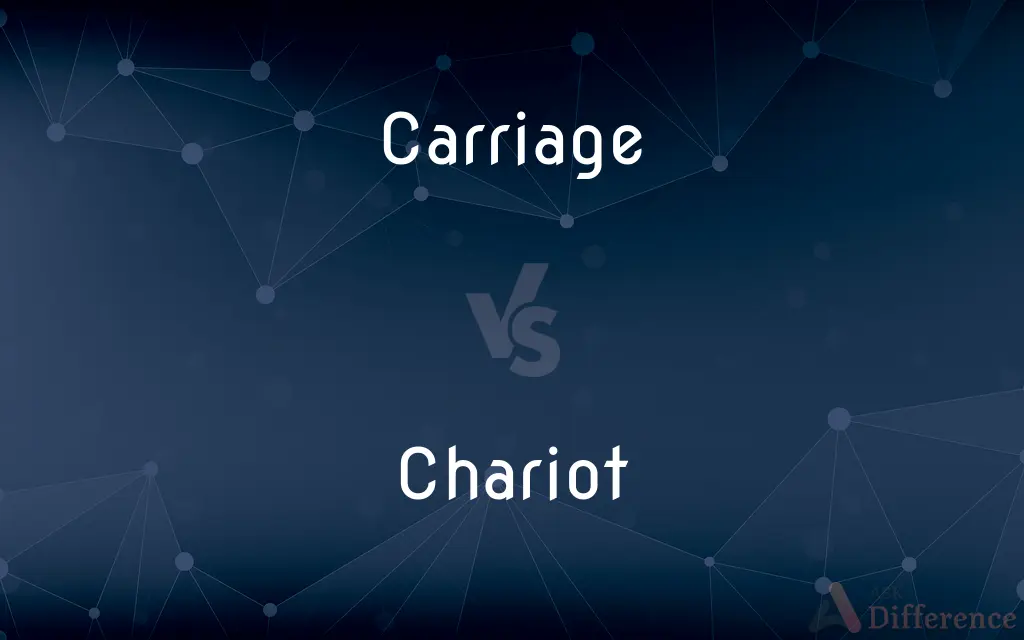Carriage vs. Chariot — What's the Difference?
Edited by Tayyaba Rehman — By Fiza Rafique — Updated on March 22, 2024
A carriage is a wheeled vehicle for people, often horse-drawn and used for leisure or transport, whereas a chariot is an ancient two-wheeled vehicle used in battles and races, typically drawn by horses.

Difference Between Carriage and Chariot
Table of Contents
ADVERTISEMENT
Key Differences
Carriages are designed for comfort and leisure, often enclosed with seating for passengers and used for personal transport or ceremonial purposes. Chariots, on the other hand, were ancient vehicles designed for speed and agility, used primarily in warfare and racing, with a standing platform for the charioteer.
While carriages are a part of historical and modern transportation, featuring various designs like stagecoaches and buggies, chariots are specific to ancient times and civilizations, such as the Romans and Egyptians, known for their use in battle and sport.
Carriages are typically more substantial and equipped for longer distances, providing seating for multiple passengers and often pulled by two or more horses. Chariots were lightweight and built for quick maneuverability, usually drawn by two horses, and used for short, fast-paced activities.
In terms of construction, carriages are often more elaborately crafted, with attention to comfort and aesthetics, including suspension systems for a smoother ride. Chariots were constructed with practicality for their specific use in mind, focusing on speed and minimalism, without much consideration for passenger comfort.
The cultural significance of carriages varies, from everyday transport in the past to a symbol of luxury and status in certain contexts today. Chariots, however, hold a place in historical and mythological narratives, symbolizing power, competition, and military prowess.
ADVERTISEMENT
Comparison Chart
Primary Use
Transport and leisure, including personal and ceremonial use.
Warfare and racing in ancient times.
Design
Enclosed with seating, designed for comfort.
Open, with a standing platform, designed for speed and agility.
Historical Context
Used historically and in modern times in various forms.
Specific to ancient civilizations and no longer in use.
Passenger Capacity
Designed to seat multiple passengers.
Typically built for one or two occupants, mainly the charioteer.
Construction
Often elaborately crafted with attention to aesthetics and comfort.
Lightweight and minimalistic, built for quick maneuvers.
Compare with Definitions
Carriage
Wheeled vehicle for transport.
They arrived at the ball in an elegant horse-drawn carriage.
Chariot
Ancient two-wheeled vehicle.
The warrior rode into battle on a swift chariot.
Carriage
Designed for comfort.
The royal carriage was fitted with plush velvet seats.
Chariot
Used in warfare.
Chariots were a formidable part of the ancient army's arsenal.
Carriage
Symbol of status.
The wealthy family owned several luxurious carriages.
Chariot
Designed for speed.
The lightweight design allowed the chariot to race across the plains.
Carriage
Used for leisure.
They took a leisurely carriage ride through the park.
Chariot
Standing platform for the charioteer.
The charioteer stood ready on the chariot's platform.
Carriage
Enclosed with seating.
The carriage offered shelter from the rain with its enclosed design.
Chariot
Historical and mythological significance.
Chariots are often depicted in ancient mythology as vehicles of the gods.
Carriage
A carriage is a private four-wheeled vehicle for people and is most commonly horse-drawn. Second-hand private carriages were common public transport, the equivalent of modern cars used as taxis.
Chariot
A chariot is a type of carriage driven by a charioteer, usually using horses to provide rapid motive power. The oldest known chariots have been found in burials of the Sintashta culture in modern-day Russia, dated to c.
Carriage
A wheeled vehicle, especially a four-wheeled horse-drawn passenger vehicle, often of an elegant design.
Chariot
An ancient horse-drawn two-wheeled vehicle used in war, races, and processions.
Carriage
Chiefly British A railroad passenger car.
Chariot
A light four-wheeled carriage used for occasions of ceremony or for pleasure.
Carriage
A baby carriage.
Chariot
To convey or ride in a chariot.
Carriage
A wheeled support or frame for carrying a heavy object, such as a cannon.
Chariot
A (two-wheeled) horse-drawn cart, used in Bronze Age and Early Iron Age warfare.
Carriage
A moving part of a machine for holding or shifting another part
The carriage of a typewriter.
Chariot
A light (four-wheeled) carriage used for ceremonial or pleasure purposes.
Carriage
The act or process of transporting or carrying.
Chariot
(xiangqi) rook
Carriage
(kărē-ĭj) The cost of or the charge for transporting.
Chariot
To convey by, or as if by, chariot.
Carriage
The manner of holding and moving one's head and body; bearing.
Chariot
(intransitive) To ride in a chariot.
Carriage
(Archaic) Management; administration.
Chariot
A two-wheeled car or vehicle for war, racing, state processions, etc.
First moved the chariots, after whom the foot.
Carriage
The act of conveying; carrying.
Chariot
A four-wheeled pleasure or state carriage, having one seat.
Carriage
Means of conveyance.
Chariot
To convey in a chariot.
Carriage
A (mostly four-wheeled) lighter vehicle chiefly designed to transport people, generally drawn by horse power.
The carriage ride was very romantic.
Chariot
A light four-wheel horse-drawn ceremonial carriage
Carriage
A railroad car
Chariot
A two-wheeled horse-drawn battle vehicle; used in war and races in ancient Egypt and Greece and Rome
Carriage
The manner or posture in which one holds or positions a body part, such as one's arm or head.
The runner has a very low arm carriage.
Chariot
Transport in a chariot
Carriage
A manner of walking and moving in general; how one carries oneself, bearing, gait.
Chariot
Ride in a chariot
Carriage
(archaic) One's behaviour, or way of conducting oneself towards others.
Carriage
The part of a typewriter supporting the paper.
Carriage
A shopping cart.
Carriage
(British) A stroller; a baby carriage.
Carriage
The charge made for conveying (especially in the phrases carriage forward, when the charge is to be paid by the receiver, and carriage paid).
Carriage
(archaic) That which is carried, baggage
Carriage
That which is carried; burden; baggage.
David left his carriage in the hand of the keeper of the carriage.
And after those days we took up our carriages and went up to Jerusalem.
Carriage
The act of carrying, transporting, or conveying.
Nine days employed in carriage.
Carriage
The price or expense of carrying.
Carriage
That which carries of conveys,
Carriage
The manner of carrying one's self; behavior; bearing; deportment; personal manners.
His gallant carriage all the rest did grace.
Carriage
The act or manner of conducting measures or projects; management.
The passage and whole carriage of this action.
Carriage
A railcar where passengers ride
Carriage
A vehicle with four wheels drawn by two or more horses
Carriage
Characteristic way of bearing one's body;
Stood with good posture
Carriage
A machine part that carries something else
Carriage
A small vehicle with four wheels in which a baby or child is pushed around
Common Curiosities
How did the design of chariots contribute to their use in warfare?
Chariots were designed to be lightweight and fast, allowing warriors to quickly maneuver in battle, launch attacks, and retreat swiftly.
What distinguishes a carriage from a chariot?
A carriage is designed for comfort and leisurely transport, often enclosed with seating, whereas a chariot is an ancient, lightweight, two-wheeled vehicle designed for speed, used in warfare and racing.
What is the cultural significance of chariots?
Chariots hold significant cultural and mythological importance, symbolizing power, prestige, and technological advancement in ancient civilizations.
Were chariots used globally in ancient times?
Chariots were used in various ancient civilizations across the world, including in Europe, Asia, and Africa, with designs and purposes varying regionally.
What was the primary purpose of chariots in ancient times?
Chariots were primarily used for military purposes and in sporting events like races, valued for their speed and agility.
Can carriages and chariots be drawn by the same animals?
Both carriages and chariots can be horse-drawn, but carriages can also be pulled by other animals like oxen, depending on the region and historical period.
Are carriages still used today?
Yes, carriages are still used today, though mainly for ceremonial purposes, tourism, or leisure, rather than as a primary mode of transport.
What advancements replaced the use of chariots in warfare?
The development of cavalry, with soldiers mounted directly on horses, eventually replaced chariots in warfare due to greater flexibility and efficiency.
How do modern representations of carriages and chariots differ from their historical uses?
Modern representations often romanticize carriages as symbols of luxury and fairy-tale weddings, while chariots are depicted in historical dramas and literature as emblematic of ancient warfare and competition.
How has the role of carriages in society changed over time?
The role of carriages has evolved from an essential mode of transportation to a more ceremonial and leisure-oriented use, largely replaced by motorized vehicles for daily transport.
Share Your Discovery

Previous Comparison
Lienor vs. Lienee
Next Comparison
Elasticity vs. DuctilityAuthor Spotlight
Written by
Fiza RafiqueFiza Rafique is a skilled content writer at AskDifference.com, where she meticulously refines and enhances written pieces. Drawing from her vast editorial expertise, Fiza ensures clarity, accuracy, and precision in every article. Passionate about language, she continually seeks to elevate the quality of content for readers worldwide.
Edited by
Tayyaba RehmanTayyaba Rehman is a distinguished writer, currently serving as a primary contributor to askdifference.com. As a researcher in semantics and etymology, Tayyaba's passion for the complexity of languages and their distinctions has found a perfect home on the platform. Tayyaba delves into the intricacies of language, distinguishing between commonly confused words and phrases, thereby providing clarity for readers worldwide.
















































